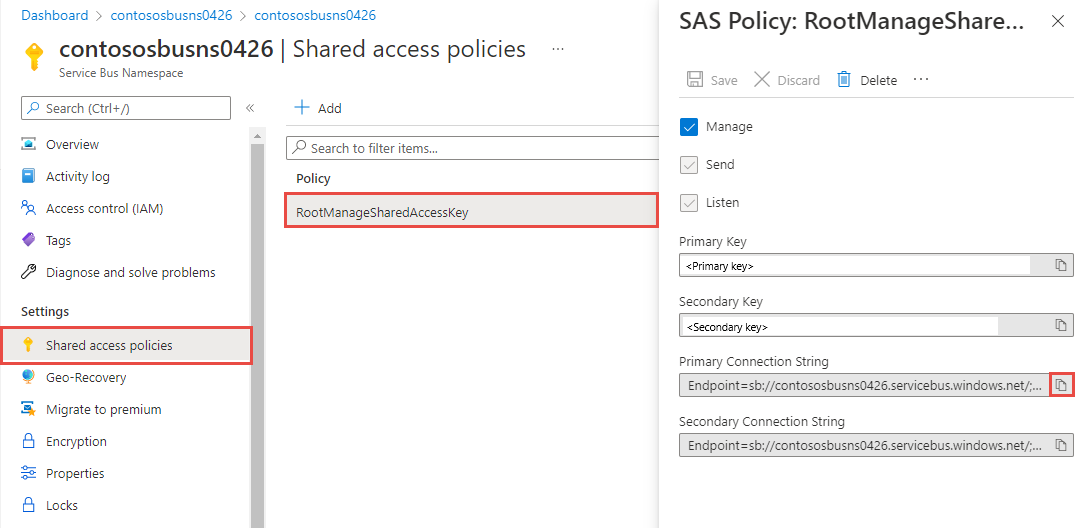Send messages to an Azure Service Bus topic and receive messages from subscriptions to the topic (Python)
In this tutorial, you complete the following steps:
- Create a Service Bus namespace, using the Azure portal.
- Create a Service Bus topic, using the Azure portal.
- Create a Service Bus subscription to that topic, using the Azure portal.
- Write a Python application to use the azure-servicebus package to:
- Send a set of messages to the topic.
- Receive those messages from the subscription.
Note
This quickstart provides step-by-step instructions for a simple scenario of sending a batch of messages to a Service Bus topic and receiving those messages from a subscription of the topic. You can find pre-built Python samples for Azure Service Bus in the Azure SDK for Python repository on GitHub.
Prerequisites
- An Azure subscription.
- Python 3.8 or higher
Note
This tutorial works with samples that you can copy and run using Python. For instructions on how to create a Python application, see Create and deploy a Python application to an Azure Website. For more information about installing packages used in this tutorial, see the Python Installation Guide.
Create a namespace in the Azure portal
To begin using Service Bus messaging entities in Azure, you must first create a namespace with a name that is unique across Azure. A namespace provides a scoping container for Service Bus resources (queues, topics, etc.) within your application.
To create a namespace:
Sign in to the Azure portal.
Navigate to the All services page.
On the left navigation bar, select Integration from the list of categories, hover the mouse over Service Bus, and then select + button on the Service Bus tile.
In the Basics tag of the Create namespace page, follow these steps:
For Subscription, choose an Azure subscription in which to create the namespace.
For Resource group, choose an existing resource group, or create a new one.
Enter a name for the namespace. The namespace name should adhere to the following naming conventions:
- The name must be unique across Azure. The system immediately checks to see if the name is available.
- The name length is at least 6 and at most 50 characters.
- The name can contain only letters, numbers, hyphens
-. - The name must start with a letter and end with a letter or number.
- The name doesn't end with
-sbor-mgmt.
For Location, choose the region in which your namespace should be hosted.
For Pricing tier, select the pricing tier (Basic, Standard, or Premium) for the namespace. For this quickstart, select Standard.
If you select Premium tier, select whether you can enable geo-replication for the namespace. The Geo-Replication feature ensures that the metadata and data of a namespace are continuously replicated from a primary region to one or more secondary regions.
Important
If you want to use topics and subscriptions, choose either Standard or Premium. Topics/subscriptions aren't supported in the Basic pricing tier.
If you selected the Premium pricing tier, specify the number of messaging units. The premium tier provides resource isolation at the CPU and memory level so that each workload runs in isolation. This resource container is called a messaging unit. A premium namespace has at least one messaging unit. You can select 1, 2, 4, 8 or 16 messaging units for each Service Bus Premium namespace. For more information, see Service Bus Premium Messaging.
Select Review + create at the bottom of the page.
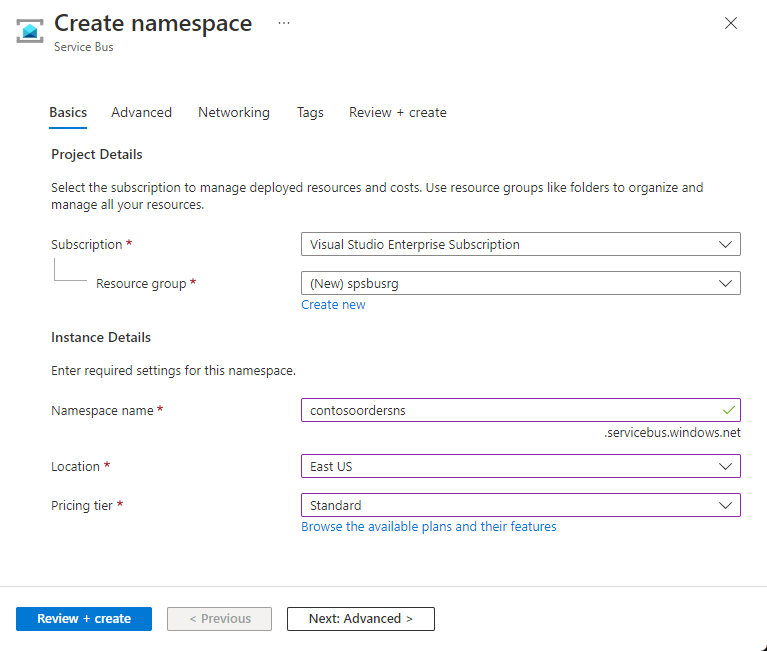
On the Review + create page, review settings, and select Create.
Once the deployment of the resource is successful, select Go to resource on the deployment page.
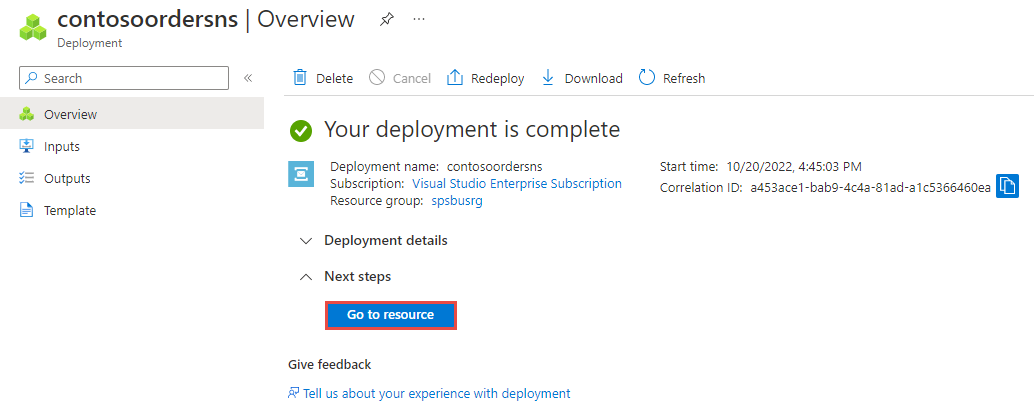
You see the home page for your service bus namespace.
Create a topic using the Azure portal
On the Service Bus Namespace page, expand Entities on the navigational menu to the left, and select Topics on the left menu.
Select + Topic on the toolbar.
Enter a name for the topic. Leave the other options with their default values.
Select Create.
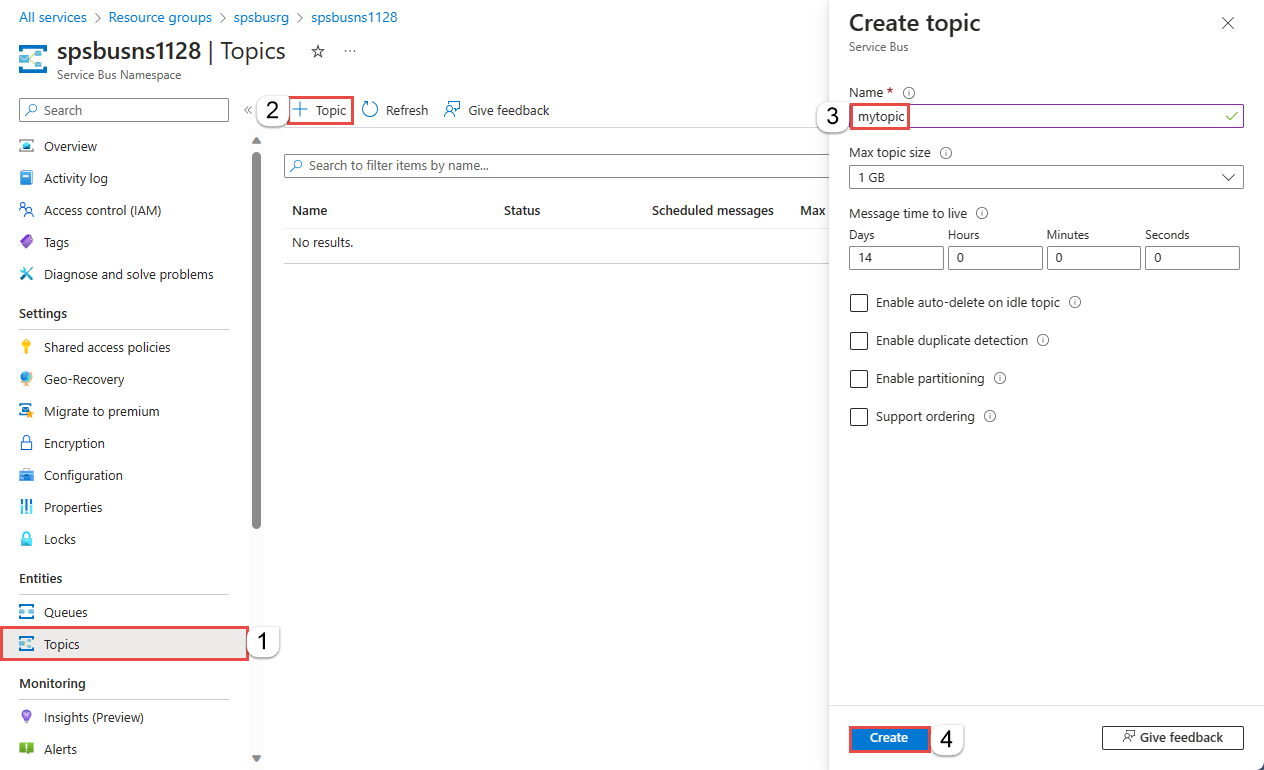
Create a subscription to the topic
Select the topic that you created in the previous section.
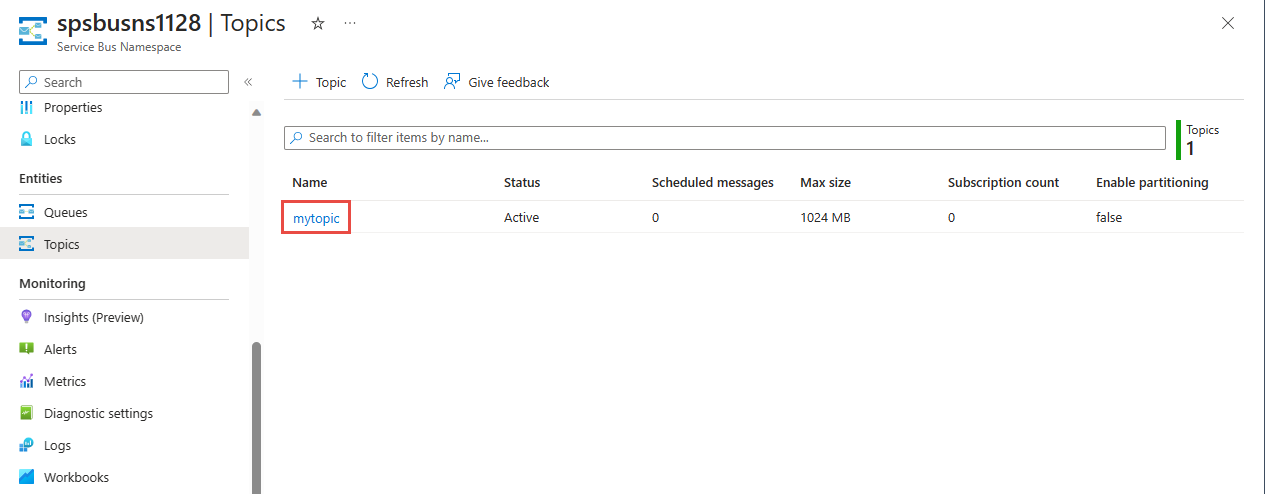
On the Service Bus Topic page, select + Subscription on the toolbar.
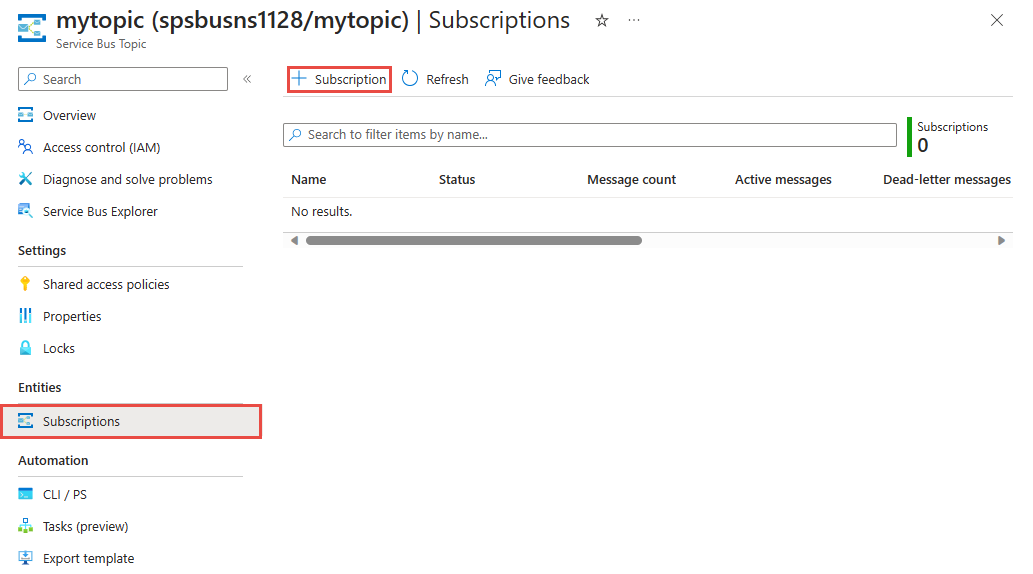
On the Create subscription page, follow these steps:
Enter S1 for name of the subscription.
Then, select Create to create the subscription.
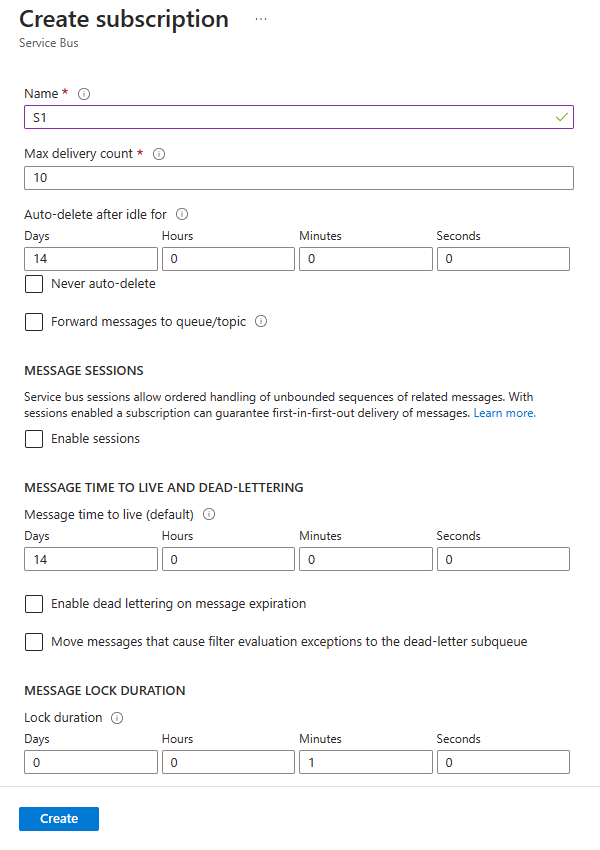
Authenticate the app to Azure
This quick start shows you two ways of connecting to Azure Service Bus: passwordless and connection string.
The first option shows you how to use your security principal in Microsoft Entra ID and role-based access control (RBAC) to connect to a Service Bus namespace. You don't need to worry about having hard-coded connection string in your code or in a configuration file or in a secure storage like Azure Key Vault.
The second option shows you how to use a connection string to connect to a Service Bus namespace. If you are new to Azure, you may find the connection string option easier to follow. We recommend using the passwordless option in real-world applications and production environments. For more information, see Authentication and authorization. You can also read more about passwordless authentication on the overview page.
Assign roles to your Microsoft Entra user
When developing locally, make sure that the user account that connects to Azure Service Bus has the correct permissions. You'll need the Azure Service Bus Data Owner role in order to send and receive messages. To assign yourself this role, you'll need the User Access Administrator role, or another role that includes the Microsoft.Authorization/roleAssignments/write action. You can assign Azure RBAC roles to a user using the Azure portal, Azure CLI, or Azure PowerShell. Learn more about the available scopes for role assignments on the scope overview page.
The following example assigns the Azure Service Bus Data Owner role to your user account, which provides full access to Azure Service Bus resources. In a real scenario, follow the Principle of Least Privilege to give users only the minimum permissions needed for a more secure production environment.
Azure built-in roles for Azure Service Bus
For Azure Service Bus, the management of namespaces and all related resources through the Azure portal and the Azure resource management API is already protected using the Azure RBAC model. Azure provides the below Azure built-in roles for authorizing access to a Service Bus namespace:
- Azure Service Bus Data Owner: Enables data access to Service Bus namespace and its entities (queues, topics, subscriptions, and filters). A member of this role can send and receive messages from queues or topics/subscriptions.
- Azure Service Bus Data Sender: Use this role to give the send access to Service Bus namespace and its entities.
- Azure Service Bus Data Receiver: Use this role to give the receive access to Service Bus namespace and its entities.
If you want to create a custom role, see Rights required for Service Bus operations.
Add Microsoft Entra user to Azure Service Bus Owner role
Add your Microsoft Entra user name to the Azure Service Bus Data Owner role at the Service Bus namespace level. It will allow an app running in the context of your user account to send messages to a queue or a topic, and receive messages from a queue or a topic's subscription.
Important
In most cases, it will take a minute or two for the role assignment to propagate in Azure. In rare cases, it may take up to eight minutes. If you receive authentication errors when you first run your code, wait a few moments and try again.
If you don't have the Service Bus Namespace page open in the Azure portal, locate your Service Bus namespace using the main search bar or left navigation.
On the overview page, select Access control (IAM) from the left-hand menu.
On the Access control (IAM) page, select the Role assignments tab.
Select + Add from the top menu and then Add role assignment from the resulting drop-down menu.
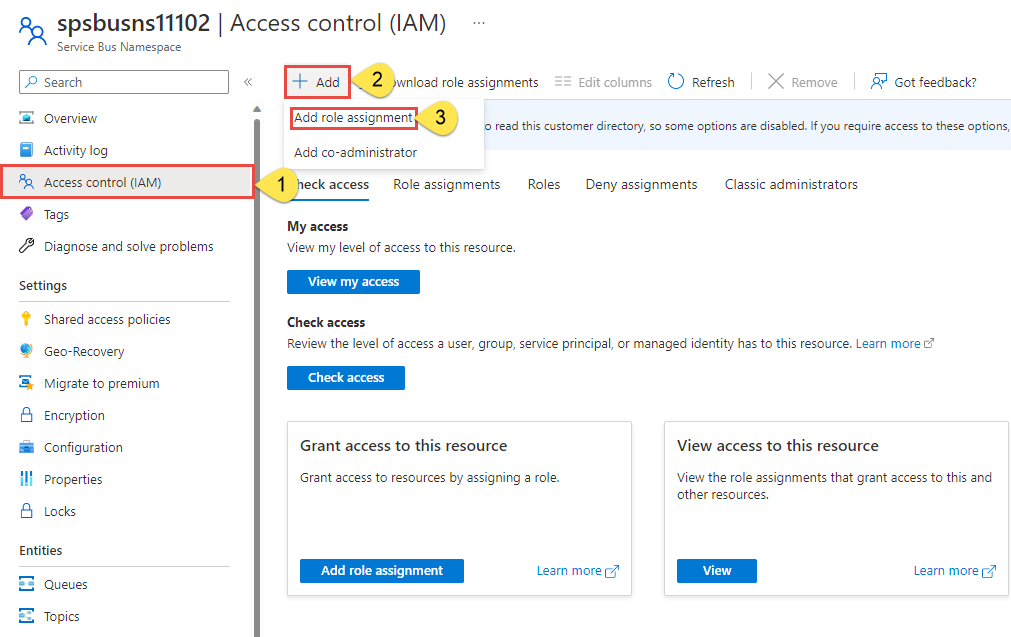
Use the search box to filter the results to the desired role. For this example, search for
Azure Service Bus Data Ownerand select the matching result. Then choose Next.Under Assign access to, select User, group, or service principal, and then choose + Select members.
In the dialog, search for your Microsoft Entra username (usually your user@domain email address) and then choose Select at the bottom of the dialog.
Select Review + assign to go to the final page, and then Review + assign again to complete the process.
Code setup
To follow this quickstart using passwordless authentication and your own Azure account:
- Install the Azure CLI.
- Sign in with your Azure account at the terminal or command prompt with
az login. - Use the same account when you add the appropriate role to your resource later in the tutorial.
- Run the tutorial code in the same terminal or command prompt.
Important
Make sure you sign in with az login. The DefaultAzureCredential class in the passwordless code uses the Azure CLI credentials to authenticate with Microsoft Entra ID.
To use the passwordless code, you'll need to specify a:
- fully qualified service bus namespace, for example: <service-bus-namespace>.servicebus.windows.net
- topic name
- subscription name
Use pip to install packages
To install the required Python packages for this Service Bus tutorial, open a command prompt that has Python in its path. Change the directory to the folder where you want to have your samples.
Install packages:
pip install azure-servicebus pip install azure-identity pip install aiohttp
Send messages to a topic
The following sample code shows you how to send a batch of messages to a Service Bus topic. See code comments for details.
Open your favorite editor, such as Visual Studio Code, create a file send.py, and add the following code into it.
Add the following
importstatements.import asyncio from azure.servicebus.aio import ServiceBusClient from azure.servicebus import ServiceBusMessage from azure.identity.aio import DefaultAzureCredentialAdd the constants and define a credential.
FULLY_QUALIFIED_NAMESPACE = "FULLY_QUALIFIED_NAMESPACE" TOPIC_NAME = "TOPIC_NAME" credential = DefaultAzureCredential()Important
- Replace
FULLY_QUALIFIED_NAMESPACEwith the fully qualified namespace for your Service Bus namespace. - Replace
TOPIC_NAMEwith the name of the topic.
In the preceding code, you used the Azure Identity client library's
DefaultAzureCredentialclass. When the app runs locally during development,DefaultAzureCredentialwill automatically discover and authenticate to Azure using the account you logged into the Azure CLI with. When the app is deployed to Azure,DefaultAzureCredentialcan authenticate your app to Microsoft Entra ID via a managed identity without any code changes.- Replace
Add a method to send a single message.
async def send_single_message(sender): # Create a Service Bus message message = ServiceBusMessage("Single Message") # send the message to the topic await sender.send_messages(message) print("Sent a single message")The sender is an object that acts as a client for the topic you created. You'll create it later and send as an argument to this function.
Add a method to send a list of messages.
async def send_a_list_of_messages(sender): # Create a list of messages messages = [ServiceBusMessage("Message in list") for _ in range(5)] # send the list of messages to the topic await sender.send_messages(messages) print("Sent a list of 5 messages")Add a method to send a batch of messages.
async def send_batch_message(sender): # Create a batch of messages async with sender: batch_message = await sender.create_message_batch() for _ in range(10): try: # Add a message to the batch batch_message.add_message(ServiceBusMessage("Message inside a ServiceBusMessageBatch")) except ValueError: # ServiceBusMessageBatch object reaches max_size. # New ServiceBusMessageBatch object can be created here to send more data. break # Send the batch of messages to the topic await sender.send_messages(batch_message) print("Sent a batch of 10 messages")Create a Service Bus client and then a topic sender object to send messages.
async def run(): # create a Service Bus client using the credential. async with ServiceBusClient( fully_qualified_namespace=FULLY_QUALIFIED_NAMESPACE, credential=credential, logging_enable=True) as servicebus_client: # Get a Topic Sender object to send messages to the topic sender = servicebus_client.get_topic_sender(topic_name=TOPIC_NAME) async with sender: # Send one message await send_single_message(sender) # Send a list of messages await send_a_list_of_messages(sender) # Send a batch of messages await send_batch_message(sender) # Close credential when no longer needed. await credential.close() asyncio.run(run()) print("Done sending messages") print("-----------------------")
Receive messages from a subscription
The following sample code shows you how to receive messages from a subscription. This code continually receives new messages until it doesn't receive any new messages for 5 (max_wait_time) seconds.
Open your favorite editor, such as Visual Studio Code, create a file recv.py, and add the following code into it.
Similar to the send sample, add
importstatements, define constants that you should replace with your own values, and define a credential.import asyncio from azure.servicebus.aio import ServiceBusClient from azure.identity.aio import DefaultAzureCredential FULLY_QUALIFIED_NAMESPACE = "FULLY_QUALIFIED_NAMESPACE" SUBSCRIPTION_NAME = "SUBSCRIPTION_NAME" TOPIC_NAME = "TOPIC_NAME" credential = DefaultAzureCredential()Create a Service Bus client and then a subscription receiver object to receive messages.
async def run(): # create a Service Bus client using the credential async with ServiceBusClient( fully_qualified_namespace=FULLY_QUALIFIED_NAMESPACE, credential=credential, logging_enable=True) as servicebus_client: async with servicebus_client: # get the Subscription Receiver object for the subscription receiver = servicebus_client.get_subscription_receiver(topic_name=TOPIC_NAME, subscription_name=SUBSCRIPTION_NAME, max_wait_time=5) async with receiver: received_msgs = await receiver.receive_messages(max_wait_time=5, max_message_count=20) for msg in received_msgs: print("Received: " + str(msg)) # complete the message so that the message is removed from the subscription await receiver.complete_message(msg) # Close credential when no longer needed. await credential.close()Call the
runmethod.asyncio.run(run())
Run the app
Open a command prompt that has Python in its path, and then run the code to send and receive messages for a subscription under a topic.
python send.py; python recv.py
You should see the following output:
Sent a single message
Sent a list of 5 messages
Sent a batch of 10 messages
Done sending messages
-----------------------
Received: Single Message
Received: Message in list
Received: Message in list
Received: Message in list
Received: Message in list
Received: Message in list
Received: Message inside a ServiceBusMessageBatch
Received: Message inside a ServiceBusMessageBatch
Received: Message inside a ServiceBusMessageBatch
Received: Message inside a ServiceBusMessageBatch
Received: Message inside a ServiceBusMessageBatch
Received: Message inside a ServiceBusMessageBatch
Received: Message inside a ServiceBusMessageBatch
Received: Message inside a ServiceBusMessageBatch
Received: Message inside a ServiceBusMessageBatch
Received: Message inside a ServiceBusMessageBatch
In the Azure portal, navigate to your Service Bus namespace. On the Overview page, verify that the incoming and outgoing message counts are 16. If you don't see the counts, refresh the page after waiting for a few minutes.
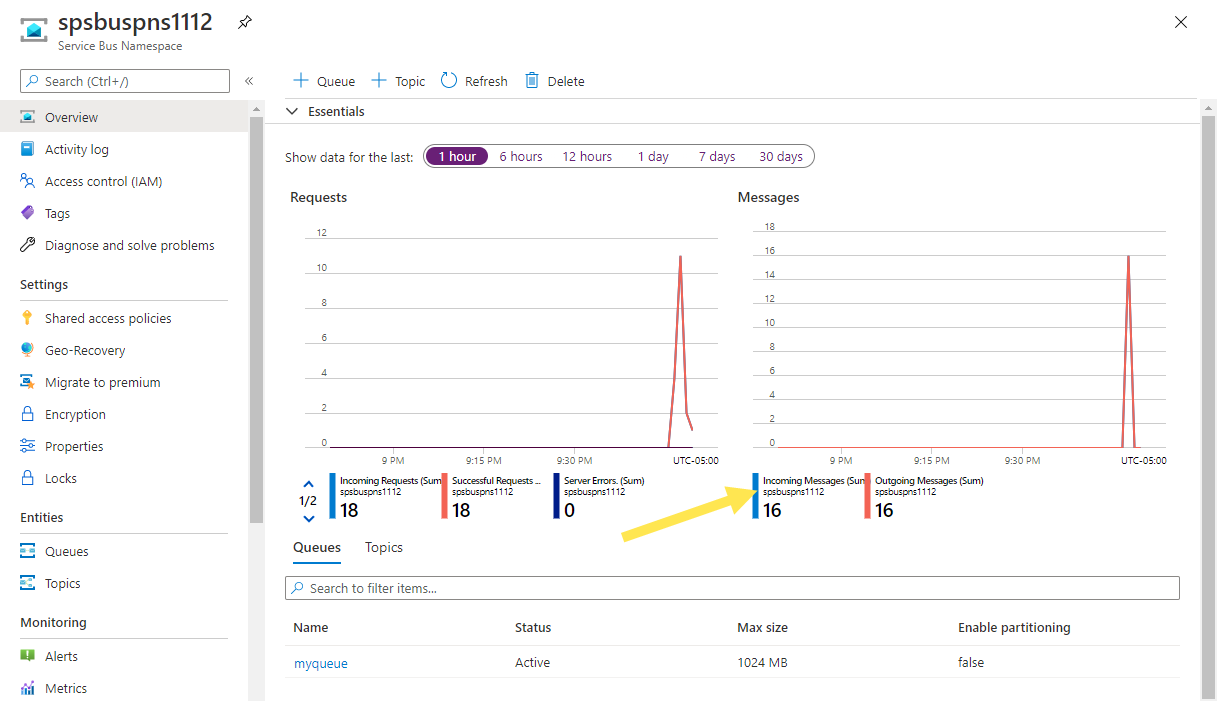
Select the topic in the bottom pane to see the Service Bus Topic page for your topic. On this page, you should see three incoming and three outgoing messages in the Messages chart.
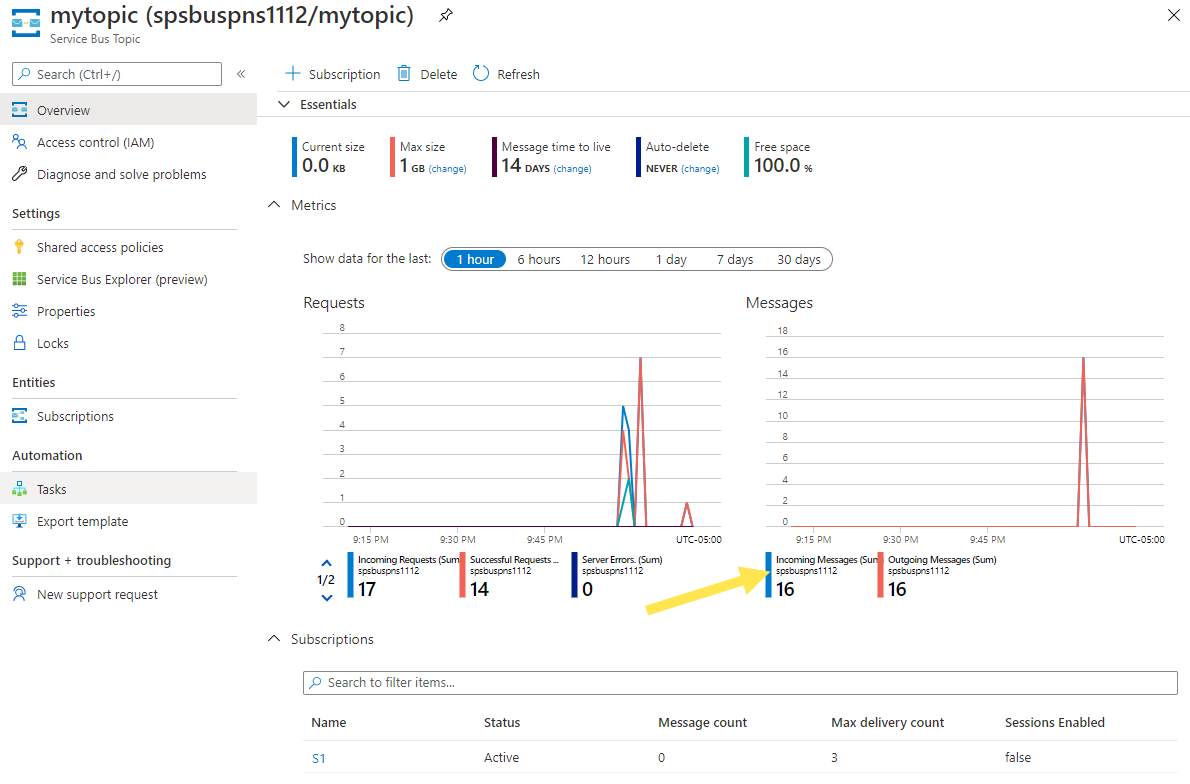
On this page, if you select a subscription, you get to the Service Bus Subscription page. You can see the active message count, dead-letter message count, and more on this page. In this example, all the messages have been received, so the active message count is zero.
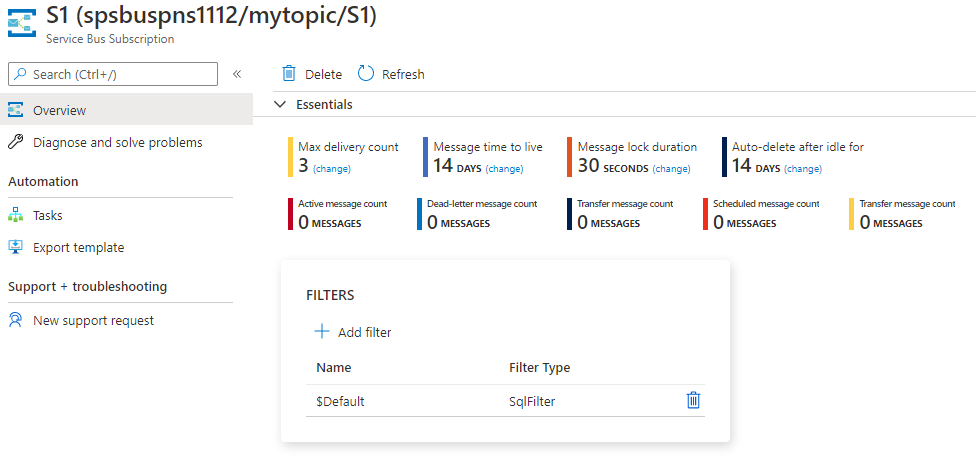
If you comment out the receive code, you'll see the active message count as 16.
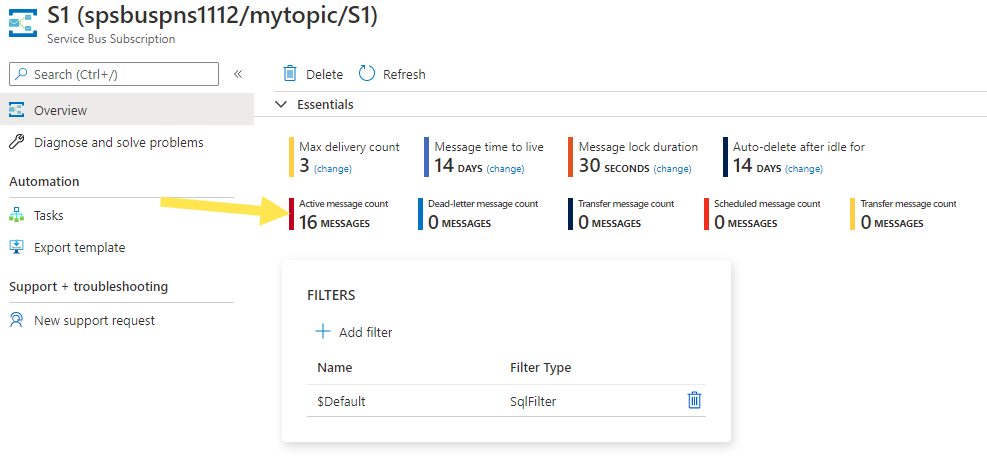
Next steps
See the following documentation and samples:
- Azure Service Bus client library for Python
- Samples.
- The sync_samples folder has samples that show you how to interact with Service Bus in a synchronous manner. In this quick start, you used this method.
- The async_samples folder has samples that show you how to interact with Service Bus in an asynchronous manner.
- azure-servicebus reference documentation


